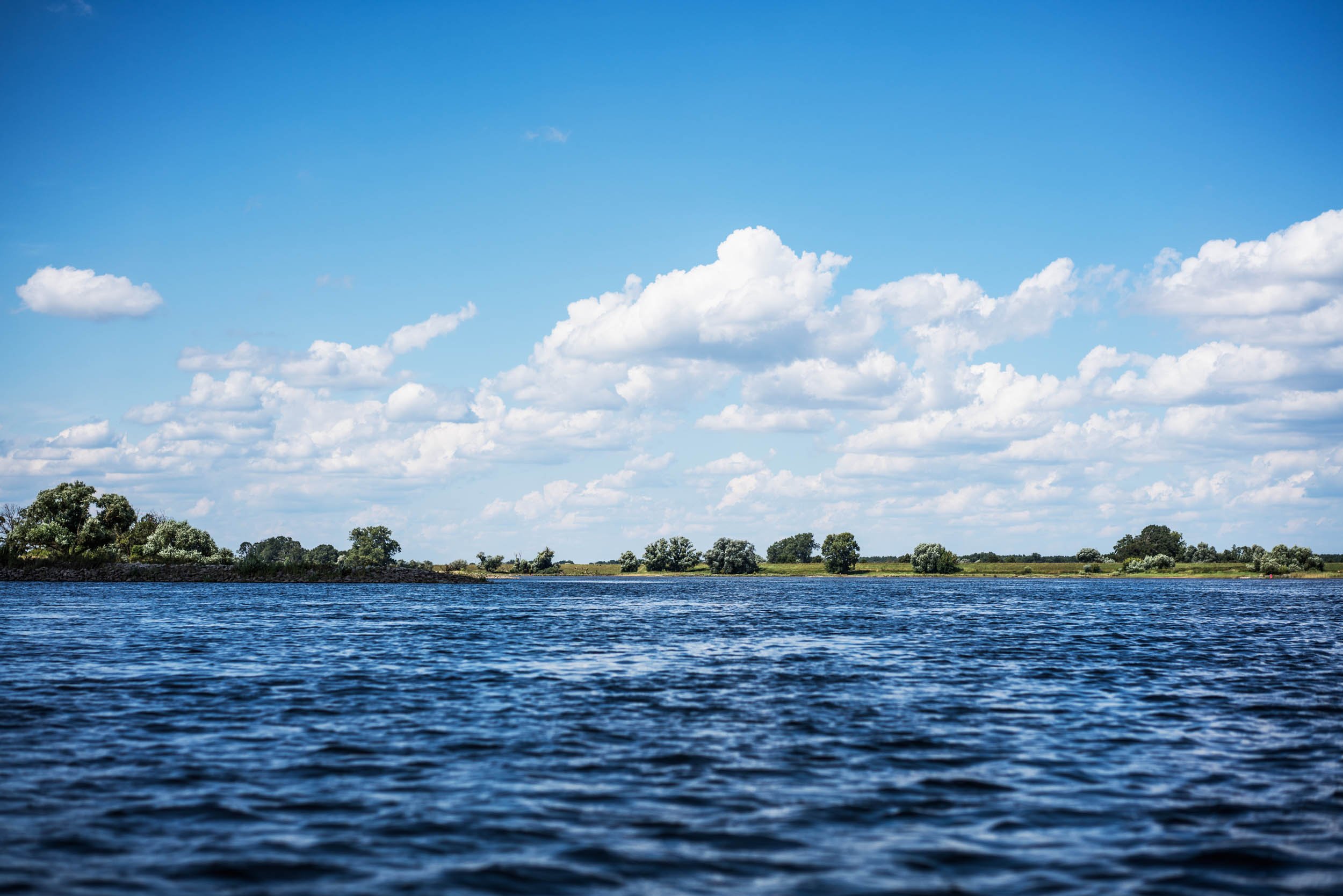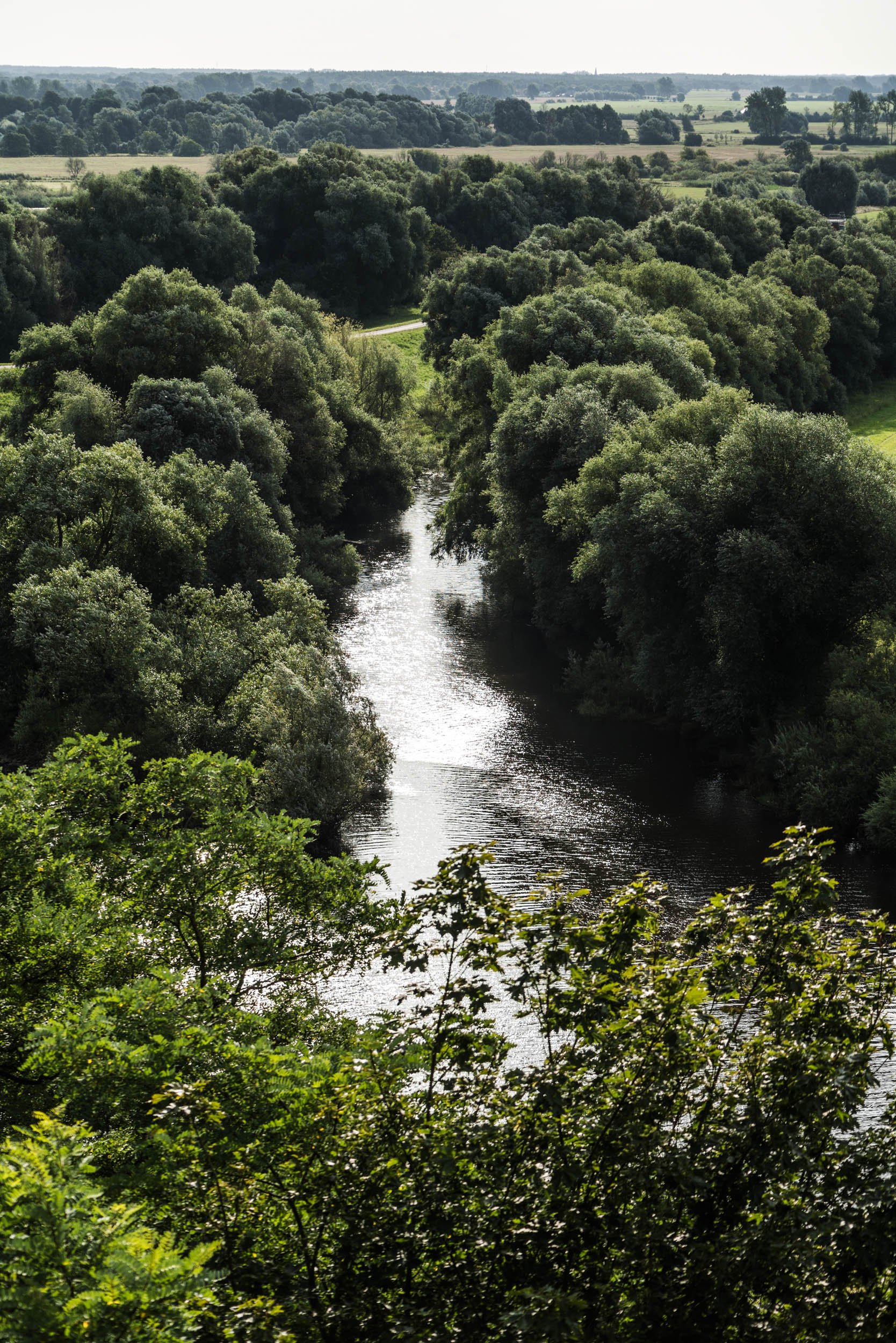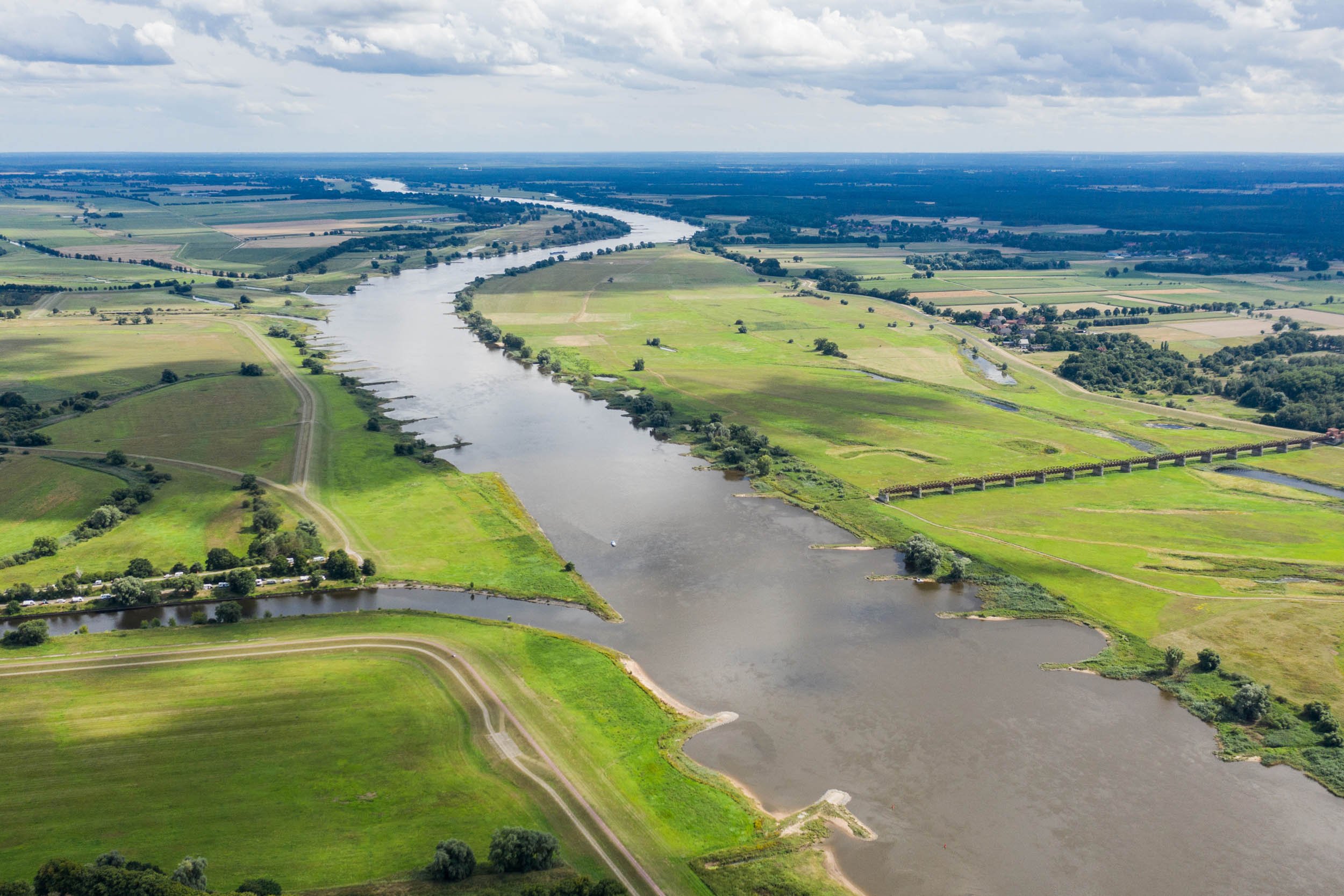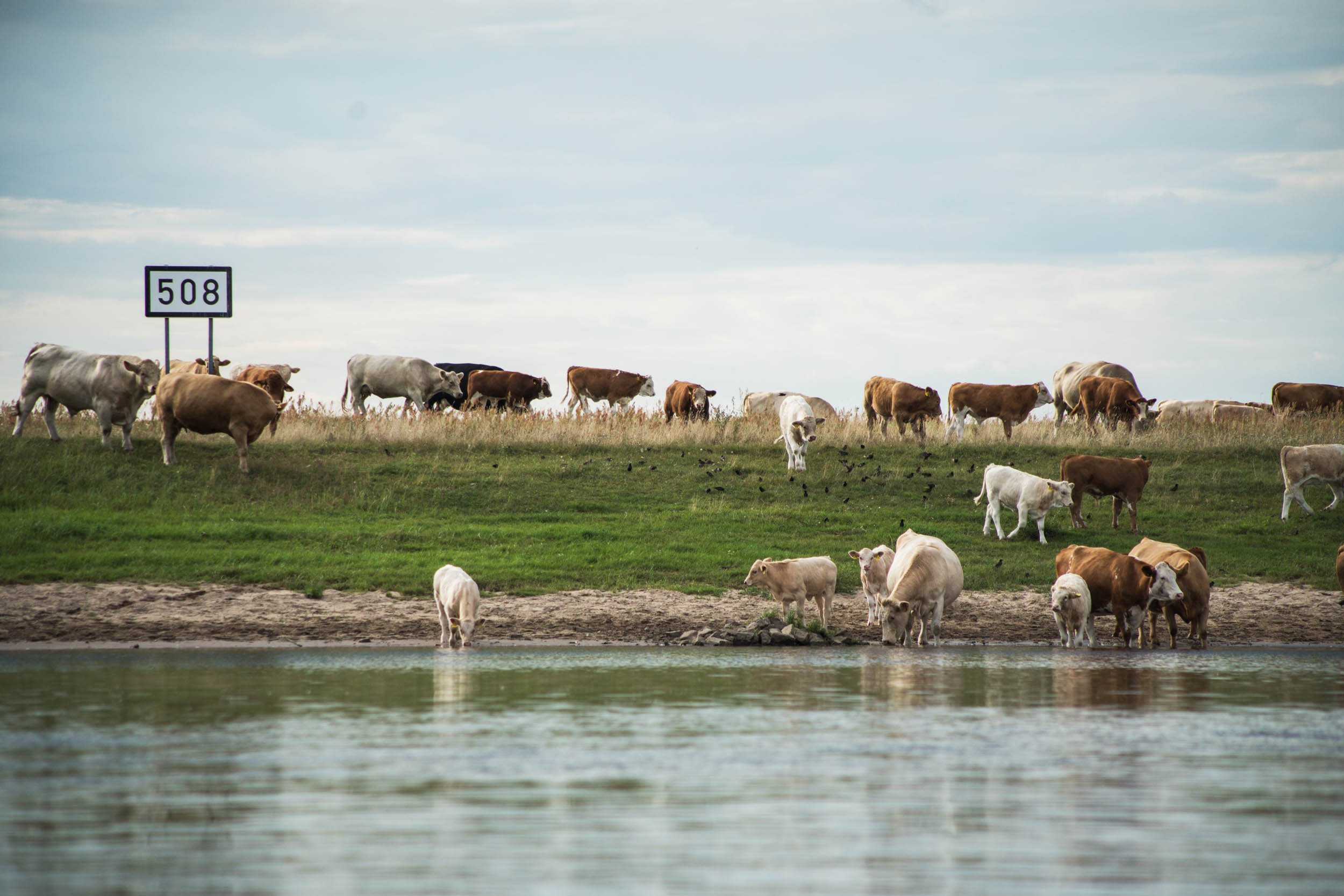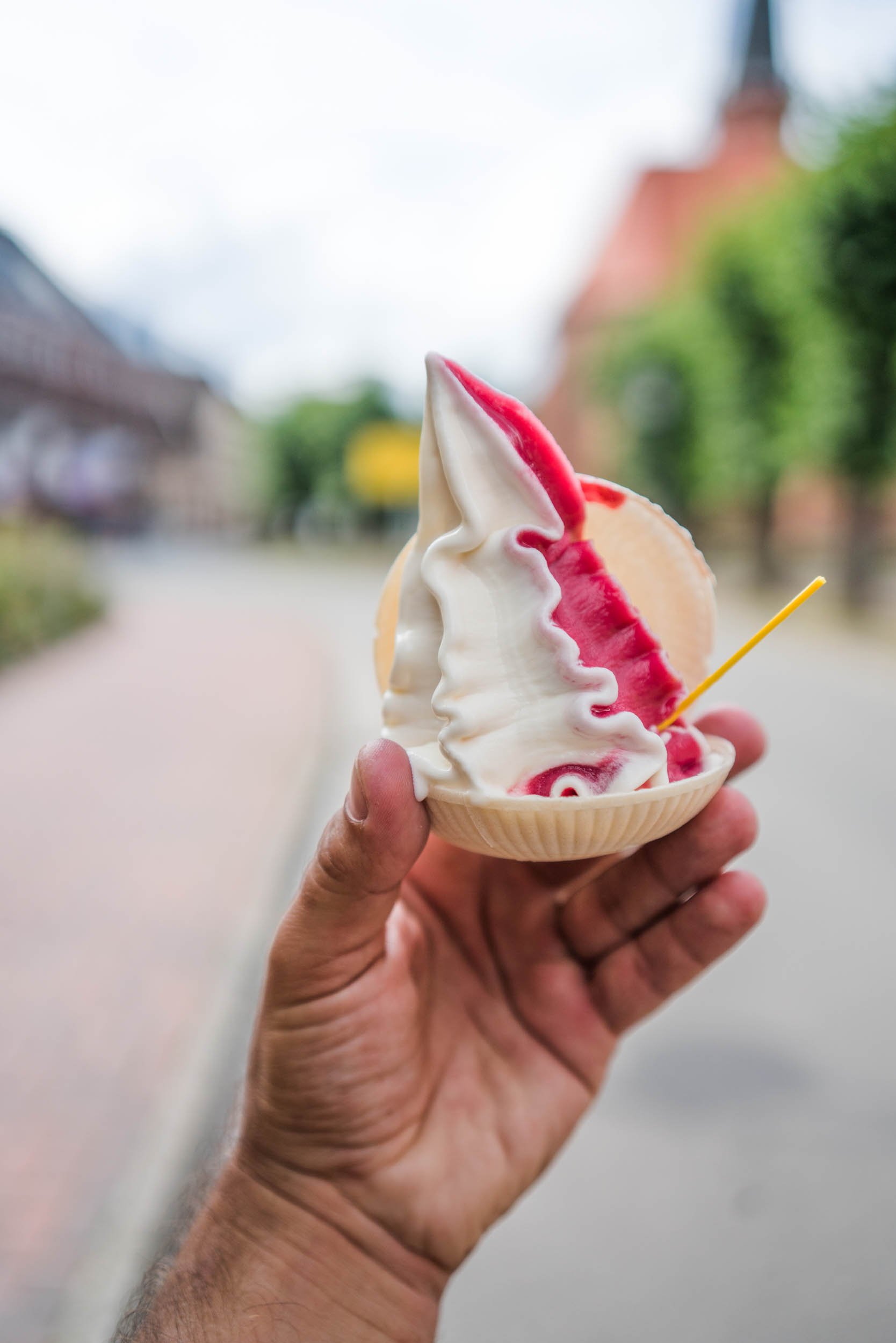Down the River in an Inflatable Boat
Who hasn’t stood by a river and thought what would happen if you just let yourself float downstream? The thought has run through my mind countless times. And now, here I was, sitting in a train from Berlin to Wittenberge, the quickest route to the Elbe river. Previously, while perusing a map, I noticed that the region between Hamburg and the German capital is, oddly enough, one of the most sparsely populated areas in Germany. This conjured up images of seclusion and an abundance of nature. Yet, before managing to embark from the shore, my little adventure already appeared to be dead in the water. After two hours of trying, I finally had to admit that the pump that came along with my cheap inflatable boat wasn’t working. A construction worker, who had been watching me with some amusement the whole time, suggested that I try getting help from the fishing shop around the corner. A short time later, I sat in my inflatable boot and turned myself around. I could hear the worker call out to me from the shore in disbelief, “So you want to go to Hamburg? Good luck!” Luck was something I could use, I thought as I clumsily tried to paddle into the waterway.
My plan was simple. The Elbe river has a flow rate of 4 kilometers an hour. In principle, that would mean I could easily travel 40 kilometers a day without any physical exertion. However, it wasn’t that easy. Without a rudder, the boat wouldn’t stay on track. Every gust of wind would blow me into the next embankment and it required a great deal of effort to escape from the surrounding eddies. After some time, I discovered a technique that allowed me to stay on course. Then came the rain and I sat soaking wet in a deep puddle. My boat had transformed into a swimming pool. Evidently, there is no such thing as an easy beginning.
On the other hand, I truly was rewarded with solitude and nature. Not a single boat crossed my way on the first day along one of the mightiest German rivers. I could hear the chatter of wild geese and saw a white-tailed eagle swoop down to catch a fish. I spotted a flock of cranes flying in formation high in the sky and caught sight of wild horses on the shore, the existence of which I had not even been aware of until then. I had arrived at the “River Landscape Elbe” Biosphere Reserve, which is recognized by UNESCO as a natural world heritage site.
The trees along the shore were bathed in the golden glow of the setting sun and my eyes were dazzled by the sight. I realized it was time to find a place to set up camp for the night. I pulled my inflatable boat onto a stretch of sandy Elbe beach and pitched my tent. I had managed to navigate 28 kilometers on the first day. It was so perfectly tranquil here that even the sound of a woodpecker in the distance seemed on a par with a jackhammer.
The next morning, I was awoken by the grunting of wild boars near my tent and was treated to an incredibly beautiful sunrise. It didn’t take long before I was off drifting down the river again. This time without wind or rain, and I could confidently have breakfast and take a snooze without the risk of drifting into an embankment. While floating downstream, I found myself being ignored by some deer drinking along the banks of the river. Even the herons took no notice of me while on the lookout for prey.
I returned to shore upon reaching the town of Mödlich. Trudging through the dewy grass alongside some storks, I made my way across the marsh to Café Elbeglück. I didn’t want to start a campfire in the nature reserve, but I still felt like having a hot coffee. I met a hiker walking along the German Green Belt, the nature reserve stretching across the former border that separated East and West Germany. He had served as an East German border guard while in the military and now wanted to see his homeland with new eyes. We spoke about the absurdity of the inner German border, but we both had to admit that it resulted in this section of the Elbe being what it is today. Nature had reclaimed the “no man’s land” between the East German watchtowers, and wildlife now thrived here.
The Elbe still seems to form a natural border here, although I could effortlessly overcome it by drifting from shore to shore in my inflatable boat. So, I continued my journey downstream to the small city of Dömitz, where I could indulge in some major nostalgia. After downing a sausage covered in ketchup, the archetypical East German fast food, I treated myself to an East German-style soft ice cream. A picture of Erich Honecker, the former communist leader, looked down from the wall and observed the changing times. An older woman sitting on her walker nodded kindly in my direction. “It tasted good back then, and it still does today.” She wasn’t wrong there. And after four days of weaving between villages along the waterway and passing through unspoiled wilderness, I arrived in Hamburg.
I certainly learned something by taking this slowest of adventure trips close to my home. The Elbe is a unique river that allows you to lose track of time. Time means nothing here. And that is just what I came here for.
Mit dem Schlauchboot auf der Elbe
Wer stand nicht schon mal am Fluss und dachte, was wohl passieren würde, wenn man sich einfach flussabwärts treiben lassen würde? Ich hatte das Gedankenspiel bereits unzählige Male. Und dann saß ich plötzlich im Zug von Berlin nach Wittenberge. Der schnellsten Verbindung zur Elbe. Auf der Landkarte war mir vorher aufgefallen, dass zwischen Hamburg und der deutschen Hauptstadt komischerweise eines der am dünnsten besiedelten Gebiete in Deutschland lag. Das versprach ein Gefühl von Abgeschiedenheit und viel Natur. Doch schon am Ufer drohte mein Mini-Abenteuer ins Wasser zu fallen. Nach zwei Stunden musste ich einsehen, dass die mitgelieferte Pumpe vom Billig-Schlauchboot kaputt war. Doch ein Baustellenarbeiter, der mir amüsiert zugeguckt hatte, riet mir, es in einem Angelladen um die Ecke zu versuchen. Kurz darauf drehte ich mich im Schlauchboot sitzend um meine eigene Achse. Vom Ufer hörte ich den Arbeiter mir nur ungläubig zurufen: „So möchtest du nach Hamburg? Viel Glück.“ Das kann ich gebrauchen, dachte ich als ich mehr als ungelenk in die Fahrrinne paddelte.
Mein Plan war einfach. Die Elbe hat eine Fließgeschwindigkeit von 4 km/h. Am Tag sollte ich also locker ohne jegliche Kraftanstrengung 40 Kilometer machen. So einfach war das aber nicht. Ohne Kiel im Wasser hielt das Schlauchboot sich nicht in der Spur. Und jeder Windstoß blies mich in die nächste Buhne aus deren Strudel ich mich mit viel Anstrengung wieder befreien musste. Aber nach einiger Zeit fand ich eine Technik mit der ich arbeiten konnte. Dann kam der Regen und ich saß durchnässt in einer tiefen Pfütze. Mein Boot hatte sich in einen Pool verwandelt. Aber aller Anfang ist schwer.
Belohnt wurde ich dafür mit einsamer Natur. Nicht ein einziges Boot kreuzte meinen Weg am ersten Tag auf einem der mächtigsten deutschen Flüsse. Wildgänse schnatterten um die Wette und ein Seeadler packte sich einen Fisch. Am Himmel flogen Kraniche eine Eins und am Ufer erspähte ich Wildpferde von deren Existenz ich bis dahin noch nicht einmal wusste. Ich war angekommen im Biosphärenreservat Flusslandschaft Elbe. Immerhin UNESCO Weltnaturerbe.
Als die Reflexionen der Abendsonne die Bäume am Ufer golden glänzen ließen und meine Augen zu blenden begannen, wusste ich, es ist Zeit sich einen Schlafplatz zu suchen. Ich zog mein Schlauchboot auf ein Stück sandigen Elbstrand und baute mein Zelt auf. Ich hatte gerade mal 28 Kilometer geschafft. Die Ruhe hier war so vollkommen, dass selbst ein Specht in der Ferne einem Presslufthammer Konkurrenz zu machen schien.
Am nächsten Morgen wurde ich dann vom Grunzen von Wildschweinen neben meinem Zelt und einem unfassbar schönen Sonnenaufgang geweckt. Kurz darauf trieb ich schon wieder den Strom hinunter. Diesmal ohne Wind und Wetter. Ich konnte getrost dösen und frühstücken ohne Gefahr zu laufen, in eine Buhne getrieben zu werden. Während ich so dahin trieb, nahmen mich die Rehe, die zum Trinken an den Fluss kamen, nicht einmal wahr. Und auch die Reiher nahmen keine Notiz von mir, während sie nach ihrer Beute Ausschau hielten.
In Mödlich ging ich dann wieder ans Ufer und stapfte neben den Störchen durch das taunasse Gras über den Werder zum Café Elbeglück. Im Naturschutzgebiet wollte ich kein Feuer machen, aber auf einen heißen Kaffee hatte ich trotzdem Lust. Hier traf ich einen Wanderer, der das Grüne Band durch die Republik entlang lief. Er war in seiner Wehrdienstzeit ostdeutscher Grenzsoldat gewesen und wollte seine Heimat mit neuen Augen sehen. Wir sprachen über die Absurdität der innerdeutschen Grenze, mussten aber auch eingestehen, dass sie diesen Abschnitt der Elbe zu dem gemacht hatte, was es heute ist. Denn zwischen den DDR-Wachtürmen hatte sich die Natur wieder etwas Wildnis zurückerobert.
Die Elbe scheint hier jedoch weiterhin eine echte Grenze zu bilden, die ich mit dem Schlauchboot von Ufer zu Ufer treibend mühelos überwinde. Und so traf ich auch etwas weiter flussabwärts in Dömitz auf Ostalgie vom Feinsten. Nach einer Kettwurst gönnte ich mir noch ein DDR-Softeis, während Honecker von der Wand herabblickte und die neue Zeit beobachtete. Eine ältere Frau nickte mir freundlich auf ihrem Rollator sitzend zu: „Das war damals gut gewesen, und ist es auch heute noch.“ Wo sie recht hat.
Nach 4 Tagen zwischen Dörfern am Deich und der Natur komme ich in Hamburg an.
Eines habe ich auf der langsamsten Abenteuerreise vor der Haustür gelernt. Die Elbe ist ein besonderer Fluss, auf dem man die Zeit vergessen kann. Sie bedeutet hier rein gar nichts. Und dafür bin ich doch hierher gekommen.
